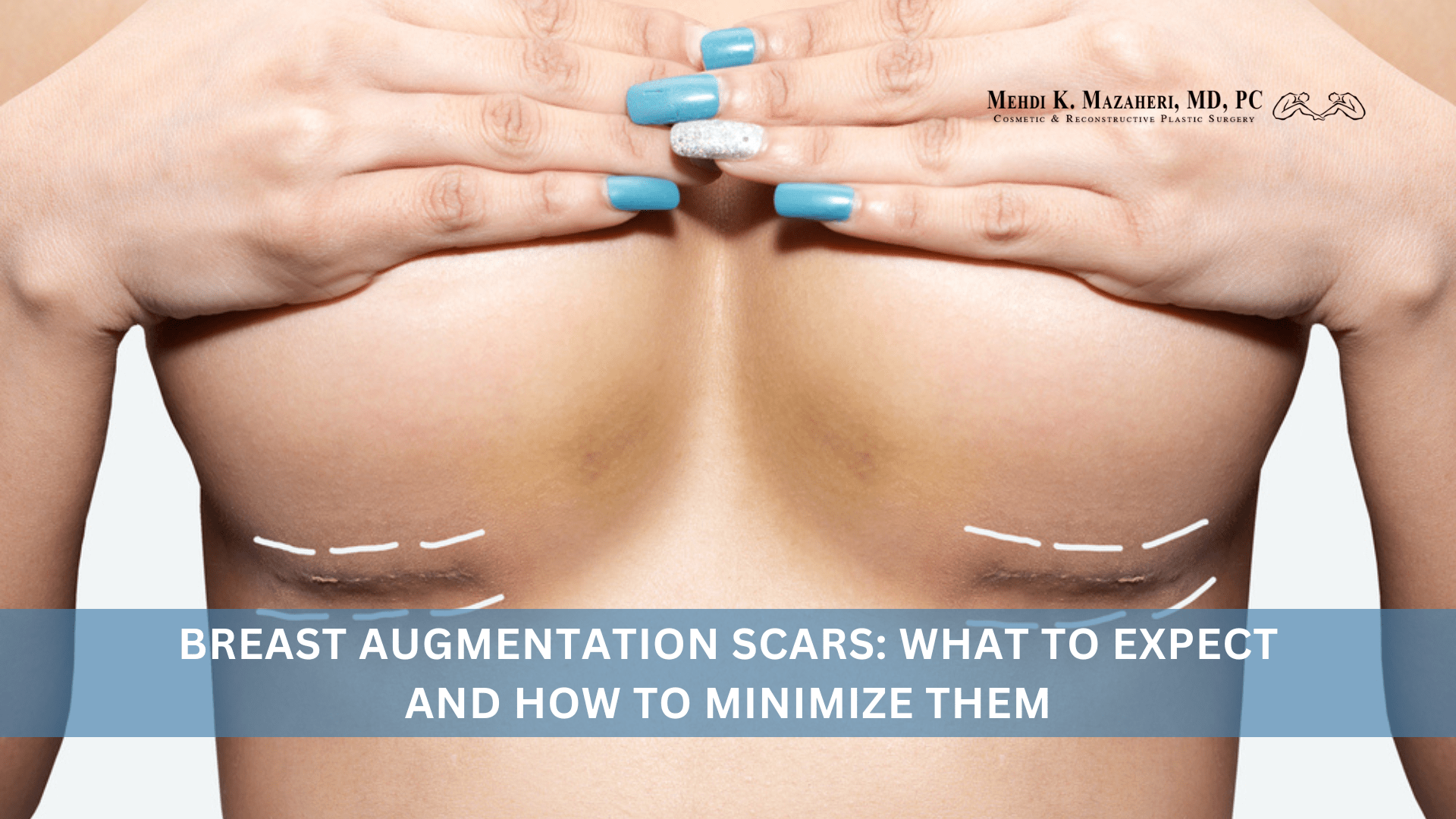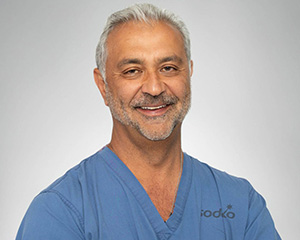Breast augmentation has become the most popular cosmetic procedure for women, with over 300,000 operations performed within the last year. While the procedure can do everything from enhanced body image, many patients fear post-procedure scarring.
Depending on the incision type, scars may be present. They may also fade over time. Continue reading to get a full understanding of various incision types, the scar healing process, how to prevent scarring, and the different treatment methods.
Page Topics
Types of Breast Augmentation Incisions & Scars
When undergoing a breast augmentation procedure, your surgeon will determine the best incision type to perform. Each incision type may produce a different type of scar. Common incision types include:
Inframammary Incision (Under the Breast Fold)
The most common type of incision performed is along the bottom of the breast. An inframammary incision allows the surgeon to place the implant and control bleeding while operating. The scarring can be well-concealed by the natural fold of the breast.
Periareolar Incision (Around the Nipple)
The surgeon makes an incision around the bottom area of the areola. From there, a small pocket is created for the breast implant, which is then placed either above or below the patient’s pectoral muscle. The areola’s natural color helps hide the scarring, but the scar’s visibility will also depend on factors like the patient’s skin color and the procedure’s healing process.
Transaxillary Incision (In the Armpit)
This incision leaves no scarring on the breast itself. In fact, the scar of this incision is easily concealable due to the natural creases of the armpit. However, keep in mind that there is still a chance that scarring may occur in areas visible with sleeveless clothing.
Transumbilical Incision (Through the Belly Button, TUBA)
A transumbilical incision is reserved for saline implants only. This is because saline implants can be filled once placed in the breast pocket, unlike silicone implants. It’s considered a “scarless” incision. That being said, a breast augmentation surgery with a TUBA incision may be limited in its ability to achieve natural-looking breast shapes.
Scar Healing Process
As you recover from breast augmentation surgery, you should notice your scars healing over time. The stages of scars healing include:
- Inflammation Stage (First Few Weeks) – The incision site may appear red and swollen during the first few weeks. This is normal as the skin is beginning to heal.
- Proliferation Stage (Weeks to Months) – This is when your body begins to produce more collagen, which strengthens the scar tissue. As this occurs, your scarring may appear darker or thicker.
- Maturation Stage (Several Months to a Year) – The scarring will gradually flatten, feel softer, and look lighter.
- Factors Affecting Healing – It’s important to remember that everyone’s skin is different. If you are considering breast augmentation, your healing may differ due to age, genetics, skin type, and even your body’s natural healing response.
It should also be noted that the techniques used by your surgeon and their post-op care also play a major role in healing. When consulting with your surgeon, be sure to ask questions about the surgical techniques used and the proper aftercare during the recovery timeline.
How to Minimize Breast Augmentation Scars
Scarring is a big concern for many patients. Luckily, there are methods you can use to minimize scarring post-op.
Pre-Surgery Considerations
Before undergoing surgery, it’s always best to choose an experienced surgeon who can prioritize minimal scarring during the procedure. From there, consult with your surgeon regarding the incision placement, as this will narrow down the best option for concealing the scarring.
Post-Surgery Care
A key part of post-op aftercare is making sure your incisions stay clean and dry. The best thing you can do is to follow your surgeon’s instructions and remember to limit your movements; excessive movements may result in complications.
Scar Treatments & Therapies
- Silicone Gel & Sheets: These are applied directly onto the scarring, reducing visibility by flattening and softening them over time.
- Scar Massage: Gently massaging the scarred area improves circulation and keeps the skin from stiffening.
- Laser Therapy & Microneedling: These additional procedures stimulate the healing process, allowing for more collagen to be produced. As a result, collagen will fill in and smooth scarring.
- Steroid Injections: This helps reduce the thickness of hypertrophic or keloid scarring
4 Lifestyle Tips for Better Scar Healing
- Sun Protection: Always protect your scars from the sun’s UV rays. Exposure to sunlight can darken the color of the scars, making them much more visible.
- Nutrition & Hydration: A healthy diet is everything post-op. Focus on foods that are rich in Vitamins C and E, as these promote collagen production. Staying hydrated helps keep your skin healthy and supple.
- Avoiding Harmful Habits: Smoking or excessive consumption of alcohol can lead to an impaired healing process and can even worsen the appearance of scars.
- Supportive Bras & Clothing: Your surgeon may recommend you wear a surgical bra post-op. These prevent any excess tension on the incisions. A normal bra is not recommended and can affect the incision sites, especially if it has underwire.
When to Seek Medical Advice
A key part of the healing process is proper professional guidance. Your surgeon is always there for your concerns and questions. But what are the insistences when you should consult them?
The best times to seek professional medical advice are:
- If you notice signs of abnormal scarring. Check your scarring for any sudden changes. This can include the scars suddenly becoming thick, raised, or even discolored. These are called Hypertrophic or keloid scars. Other abnormal signs include the scar having excessive redness, sudden itching, or feeling pain beyond the normal healing period.
- If you have a possible infection. It is best to seek professional assistance when your scarring is possibly infected. The visible signs include persistent redness, warmth from the area, pus discharges, or even an unpleasant odor. Besides visible indicators, you may have an infection if you suddenly have a fever or feel discomfort around the incision that only grows worse over time.
- If you need scar revision. If your scars do not fade over time, it is best to seek out surgical revision options or laser treatments that can better conceal your scarring.
Breast Augmentation Scars FAQ
How long does it take for breast augmentation scars to fade?
Breast augmentation scars should begin fading and flattening over several months. With the proper scar care, many patients see their scars fade within 6 to 12 months.
Can I completely get rid of my breast augmentation scars?
Unfortunately, scarring from a breast augmentation procedure will never fully go away. However, with the proper care, you can diminish the appearance of the scars. Ways to care for your skin include following the instructions from your surgeon, applying suitable ointments, and simply allowing enough recovery time.
What is the best scar treatment after breast augmentation?
While skincare may differ from patient to patient, the popular treatment for treating scars is applying silicone gel sheets. These sheets apply pressure onto the scarring while shielding the skin from bacteria. With daily use, the sheets help fade the scarring effectively. Other treatments include the use of topical silicone creams or laser treatments to smooth out the skin.
Schedule a consultation online or give Dr. Mazaheri a call at (480) 418-4950 to learn more.
Comments are closed.



